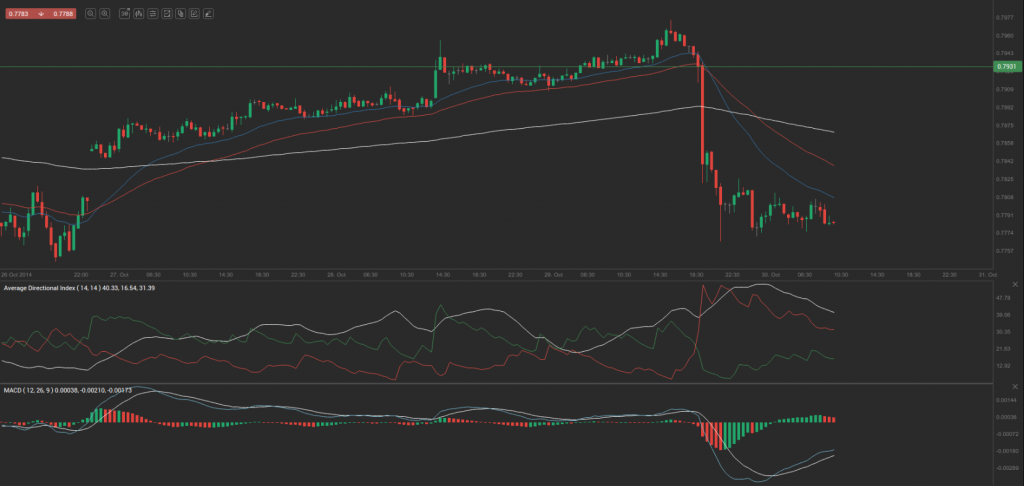Yesterday’s trade saw NZD/USD within the range of 0.7766-0.7978. The pair closed at 0.7802, losing 1.49% on a daily basis.
At 8:24 GMT today NZD/USD was down 0.21% for the day to trade at 0.7786. The pair touched a daily low at 0.7774 during early Asian trade.
Fundamentals
New Zealand
The number of building permits in New Zealand probably increased 1.0% in September compared to a month ago, according to the median estimate by experts. If so, this would be the largest gain since June, when building consents rose 3.5%. In August permits, issued by the government, registered no change. Building permits, as an indicator, provide clues over demand in New Zealand’s housing sector. In case the number of permits increased more than anticipated, this might have a bullish effect on the kiwi. Statistics New Zealand is to release its monthly report at 21:45 GMT.
United States
Initial, Continuing jobless claims
The number of people in the United States, who filed for unemployment assistance for the first time during the week ended on October 24th, probably dropped to 282 000 from 283 000 in the prior week. The 4-week moving average, an indicator lacking seasonal effects, was 281 000, a decrease of 3 000 from the previous weeks revised average. This has been the lowest level for this average since May 6th 2000, when it was reported at 279 250. The previous weeks average was revised up by 500 from 283 500 to 284 000.
Initial jobless claims number is a short-term indicator, reflecting lay-offs in the country. In case the number of claims decreased more than projected, this would have a bullish effect on the greenback.
The number of continuing jobless claims probably dropped to the seasonally adjusted 2 350 000 during the week ended on October 17th, from 2 351 000 in the previous week. The latter was a decrease by 38 000 compared to the unrevised level of 2 389 000, reported during the week ended on October 3rd. This has been the lowest level for insured unemployment since December 23rd 2000, when it was reported at 2 340 000. This indicator represents the actual number of people unemployed and currently receiving unemployment benefits, who filed for unemployment assistance at least two weeks ago.
The Department of Labor is to release the weekly report at 12:30 GMT.
Gross Domestic Product – preliminary estimate
The preliminary estimate of the US Gross Domestic Product probably pointed to an annualized rate of growth of 3.0% in the third quarter of the year. The final GDP estimate for Q2, reported on September 26th, pointed to an annual growth of 4.6%. The latter has been the highest growth rate in 2 ½ years, supported by business investment and a larger-than-projected increase in exports. Real personal consumption expenditures rose 2.5% in the second quarter of the year, compared with an increase of 1.2% in Q1. Real nonresidential fixed investment increased 9.7% in the second quarter, following another increase by 1.6% in the prior quarter. Real exports of goods and services expanded 11.1% in the second quarter, in contrast to a decrease of 9.2% in Q1, while real federal government consumption expenditures and gross investment dropped 0.9% in the second quarter, in comparison with a 0.1% dip in the previous quarter, according to data by the US Department of Commerce.
The report on GDP holds a lot of weight for traders, operating in the Foreign Exchange Market, as it serves as evidence of growth in a productive economy, or as evidence of contraction in an unproductive one. As a result, currency traders will look for higher rates of growth as a sign that interest rates will follow the same direction. Higher interest rates will attract more investors, which will increase demand for the US dollar. If an economy is experiencing a robust rate of growth, the benefits will eventually affect the end consumer, because of the increased likelihood of spending. Furthermore, through increased consumer expenditures the economy has the potential to expand even more. In case the preliminary GDP estimate outpaced expectations, this would certainly heighten the appeal of the greenback. The official data is due out at 12:30 GMT.
Pivot Points
According to Binary Tribune’s daily analysis, the central pivot point for the pair is at 0.7849. In case NZD/USD manages to breach the first resistance level at 0.7931, it will probably continue up to test 0.8061. In case the second key resistance is broken, the pair will probably attempt to advance to 0.8143.
If NZD/USD manages to breach the first key support at 0.7719, it will probably continue to slide and test 0.7637. With this second key support broken, the movement to the downside will probably continue to 0.7507.
The mid-Pivot levels for today are as follows: M1 – 0.7572, M2 – 0.7678, M3 – 0.7784, M4 – 0.7890, M5 – 0.7996, M6 – 0.8102.
In weekly terms, the central pivot point is at 0.7896. The three key resistance levels are as follows: R1 – 0.8000, R2 – 0.8145, R3 – 0.8249. The three key support levels are: S1 – 0.7751, S2 – 0.7647, S3 – 0.7502.






